In the world of cannabis, the term THCA (tetrahydrocannabinolic acid) holds significant importance, especially for those seeking potent and therapeutic effects. Tetrahydrocannabinol (THCA) is a precursor to THC (tetrahydrocannabinol), the psychoactive compound responsible for marijuana’s “high”. When cannabis flowers are harvested and undergo a drying and curing process, THCA undergoes decarboxylation, transforming into THC.

One crucial factor that enthusiasts and patients alike consider when choosing cannabis products is the THCA percentage. This percentage indicates the concentration of THCA in a given strain or product and serves as a key metric for predicting the potential potency of the final THC content post-decarboxylation.
Understanding THCA:
Cannabis plants contain many cannabinoids, including THCA. It is found in the trichomes, the tiny, resinous structures on the surface of the flowers and leaves. Since THCA is a non-psychoactive compound, it cannot induce the intoxicating effects of THC when consumed in its raw form. The drug provides a variety of therapeutic benefits without inducing euphoria.
The Conversion Process:
The transformation of THCA into THC occurs through a process known as decarboxylation, triggered by exposure to heat. This can happen through smoking or vaporization, but it is also a crucial step in the preparation of edibles and tinctures. By heating cannabis, whether by combustion or cooking, the carboxyl group (COOH) is removed from THCA, resulting in the creation of THC. The compound’s psychoactive properties are significantly enhanced by this conversion.
High THCA Percentage:
A high THCA percentage in a cannabis strain or product suggests a greater potential for higher THC levels after decarboxylation. As such, consumers seeking more potent effects may be inclined to select strains with elevated THCA concentrations. However, it’s important to note that the actual THC content may vary based on factors such as cultivation methods, processing techniques, and storage conditions. Find out more about Cannabis THCA Diamonds.
THCA and Medical Cannabis:
Medical cannabis patients often pay close attention to THCA percentages when selecting strains for their therapeutic needs. While THC is known for its psychoactive effects, some patients may benefit from the combination of THC and other cannabinoids in their raw, acidic forms, such as THCA.
It has been found that THCA has anti-inflammatory, neuroprotective, and antiemetic properties, which may make it valuable in treating a variety of medical conditions.
Entourage Effect:
Cannabis plants contain many compounds that interact synergistically, including cannabinoids, terpenes, and flavonoids. Some believe that consuming cannabis in its whole-plant form, with a balance of cannabinoids like THCA and THC, along with other compounds, can provide enhanced therapeutic effects compared to isolated compounds.
Strain Variability:
Different cannabis strains exhibit varying levels of THCA, and the ideal percentage can vary based on individual preferences and desired effects. Some strains naturally contain THCA, while others have a more balanced cannabinoid profile. Sativa, indica, and hybrid strains can all display different THCA concentrations, offering users a diverse range of options to suit their needs.
Lab Testing and Accuracy:
To provide consumers with accurate information about THCA percentages, many legal cannabis markets require lab testing of products. Consumers can make informed decisions about products they purchase based on the analysis of cannabinoid content, including THCA. However, it’s essential to recognize that testing methodologies can vary between labs, and factors like sample preparation and equipment calibration can impact the accuracy of results.
Consumption Methods and THCA Preservation:
Different consumption methods can influence the preservation of THCA in cannabis products. For instance, smoking or vaporizing involves the application of heat, leading to immediate decarboxylation and the conversion of THCA to THC. On the other hand, consuming raw cannabis, such as in juices or smoothies, allows individuals to benefit from the potential therapeutic properties of THCA without experiencing the psychoactive effects associated with THC. To know more about THCA, visit ATLRx.
Conclusion:
In the ever-evolving landscape of cannabis consumption, understanding the significance of high THCA percentages is crucial for both recreational users and medical patients. While some may prioritize strains with elevated THCA for their potential psychoactive effects, others may appreciate the therapeutic benefits of consuming THCA in its raw form. As research continues to uncover the complexities of cannabis compounds, consumers can make informed decisions based on their individual preferences and desired outcomes. Whether seeking relief from medical symptoms or simply exploring the diverse world of cannabis, the THCA percentage serves as a valuable metric in navigating the vast array of available strains and products.


